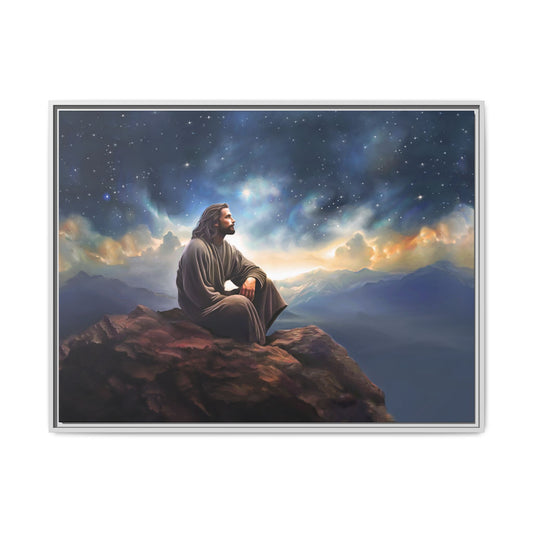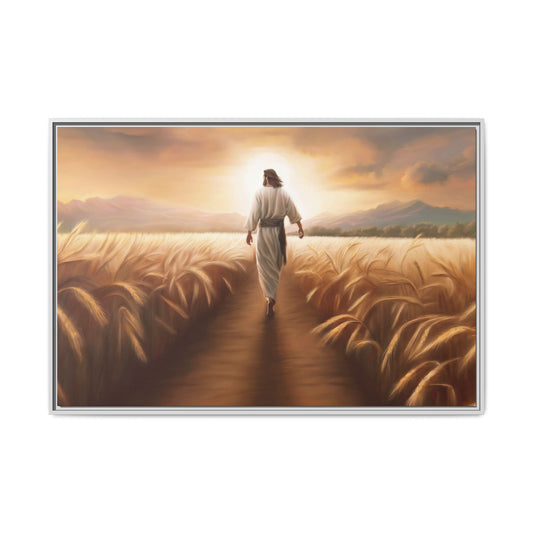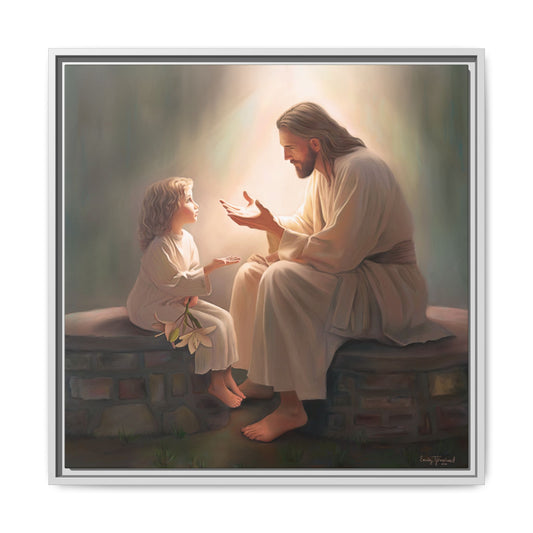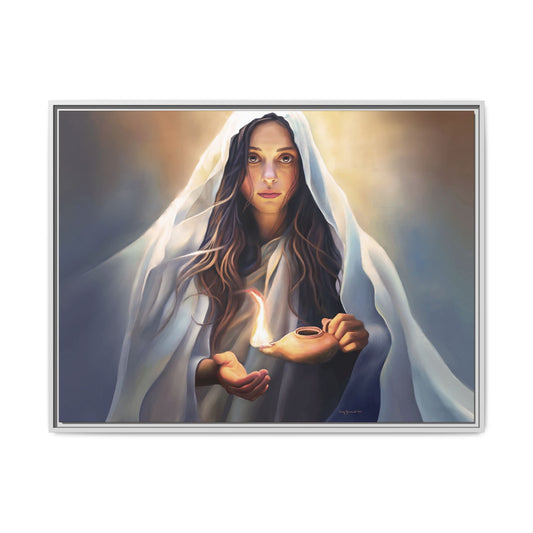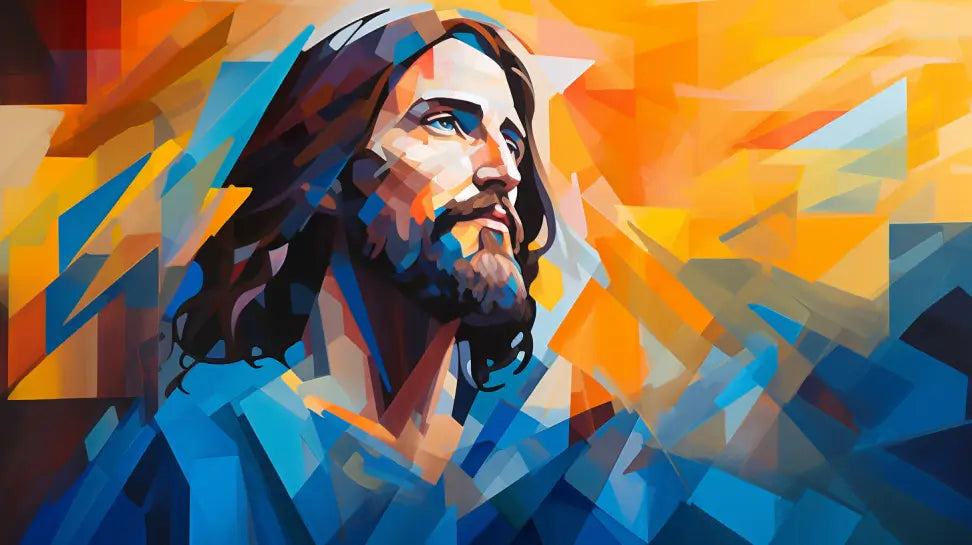
Artwork of Jesus Christ
Share
Imagine walking through a sprawling art museum, each room revealing a different portrayal of Jesus Christ. The artwork of Jesus Christ isn't just paint on a canvas, it's a profound exploration of faith, culture, and human creativity.
You'll witness the evolution of artistic techniques, see how different eras and societies pictured Christ, and uncover the impact these depictions have had on global religious understanding.
From Byzantine mosaics to contemporary digital art, the image of Jesus remains a compelling subject in the art world. As you embark on this journey, you're not just observing, you're participating in a centuries-old dialogue about the face of divinity.
Key Takeaways
- The oldest known painting of Jesus dates back to around 235 AD and was discovered in Syria.
- Jesus' appearance in early Christian art in Rome varied, with portrayals ranging from a young, beardless figure resembling the Good Shepherd to a figure with a full beard and long hair reflecting a Jewish appearance.
- European and American Christians often depicted Jesus as a white man with blue eyes and light hair, despite Jesus likely having darker skin, curly hair, and brown eyes.
- Famous paintings of Jesus include 'The Last Supper' by Leonardo da Vinci and 'The Transfiguration' by Raphael, and many others. Each painting offers a unique interpretation of Jesus' image and character.

Artwork of Jesus Christ
You've no doubt seen many images of Jesus Christ, but have you ever stopped to consider their significance? Portraits of Jesus are more than just artistic representations; they're expressions of faith that can inspire worship and deepen understanding.
From the ancient to the modern, each piece tells a unique story, reflecting the context of its creation and the beliefs of its time.
The following scriptures provide unique insights and moments from Jesus's life that artists can draw upon to create meaningful and inspiring works:
Luke 8:24-25: 'He got up and rebuked the wind and the raging waters; the storm subsided, and all was calm. "Where is your faith?" he asked his disciples.' This moment of calming the storm not only showcases Jesus's power over nature but also symbolizes His ability to bring peace to our lives amidst turmoil.
Matthew 6:28-29: 'And why worry about your clothing? Look at the lilies of the field and how they grow. They don’t work or make their clothing, yet Solomon in all his glory was not dressed as beautifully as they are.' Through this teaching, Jesus emphasizes trust in God's provision, offering a theme rich with imagery of nature's beauty and God's care.
Mark 15:37-39: 'With a loud cry, Jesus breathed his last. The curtain of the temple was torn in two from top to bottom. And when the centurion, who stood there in front of Jesus, saw how he died, he said, "Surely this man was the Son of God!"' The moment of Jesus's crucifixion and the centurion's realization offer dramatic and powerful imagery for artists to explore themes of sacrifice, revelation, and the fulfillment of Jesus's divine mission.
John 20:15-16: 'Jesus said to her, "Mary." She turned toward him and cried out in Aramaic, "Rabboni!" (which means "Teacher").' The personal encounter between the resurrected Jesus and Mary Magdalene outside the tomb provides a deeply emotional and intimate moment for artistic exploration, emphasizing recognition, reunion, and the joy of the Resurrection.
Helaman 5:12 (Book of Mormon): 'And now, my sons, remember, remember that it is upon the rock of our Redeemer, who is Christ, the Son of God, that ye must build your foundation.' This scripture encourages depictions of Christ as the sure foundation upon which we build our lives, symbolized through imagery of stability, strength, and faithfulness.
Doctrine and Covenants 110:3: 'His eyes were as a flame of fire; the hair of his head was white like the pure snow; his countenance shone above the brightness of the sun; and his voice was as the sound of the rushing of great waters.' This vivid description of Jesus Christ appearing in glory to Joseph Smith and Oliver Cowdery in the Kirtland Temple can inspire artwork that captures the majesty, power, and purity of the Savior.
Abraham 2:11: 'And I will make of thee a great nation, and I will bless thee above measure, and make thy name great among all nations, and thou shalt be a blessing unto thy seed after thee, that in their hands they shall bear this ministry and Priesthood unto all nations.' This promise to Abraham speaks to the generational and global impact of faith in God, offering artists a theme of covenant, promise, and the spreading of divine blessings through Jesus Christ.
Each scripture offers a different angle from which to approach the life and teachings of Jesus Christ, encouraging artists to explore and express the depth of His divine mission and human experience. Through "Artwork of Jesus Christ," these scriptural moments can be vividly brought to life, inviting reflection and deeper spiritual connection.

The Significance of Jesus portraits
Jesus Christ artwork is broad, encompassing various mediums, styles, and periods. They serve as visual narratives, interpreting biblical stories and embodying spiritual ideals.
The significance of these portraits extends beyond aesthetics. They influence religious perception, shape cultural identity, and stimulate philosophical discourse. Moreover, they're a testament to the enduring influence of Jesus Christ in shaping human creativity, imagination, and recognizing beauty in life.
Each piece of Jesus Christ artwork is a testament to the artist's interpretation of his divine persona, reflecting not just the historical Jesus, but the evolving perception of his image.

Worshipful Expressions of Art
I's helpful to understand the profound importance of these worshipful expressions of art in various aspects of life. The artwork of Jesus Christ indeed serves as a mirror of the soul, capturing the divine and transcendent aspects of His identity. These pieces aren't just an expression can represent a deep, spiritual connection between the artist and the divine. As a viewer, we are invited to likewise connect with heavenly things.
These worshipful expressions of art provide a visual language that transcends linguistic boundaries, enabling a wide range of people to engage with religious narratives. The importance of these artworks lies in their ability to inspire, to provoke thought, and to provide an opportunity to reflect on the divine.
Historical Overview of Jesus Portraits
You've seen how the early Christian era largely shied away from physical depictions of Jesus, opting instead for symbolic representations.
As you move forward in time, you'll note the emergence of Byzantine icons, where spiritual symbolism took precedence.
Further on, you'll encounter the Renaissance era, where artists began to humanize Jesus in their works.
Early Christian era and the absence of physical depictions
In the early Christian era, there were hardly any physical depictions of Jesus Christ to be found. The absence of these depictions wasn't due to a lack of artistic capability, but rather a theological choice. You see, early Christians were more focused on Christ's teachings than his physical form. This approach was innovative in its simplicity, it was more about the message than the messenger.
As centuries passed, the artwork of Jesus Christ evolved, adapting to cultural contexts and theological shifts. The few existing physical depictions from the early Christian era are precious fragments of a time when verbal storytelling reigned supreme. These relics offer an insightful glimpse into the foundations of Christian art and how it has transformed over time.
Emergence of Byzantine icons and their spiritual symbolism
When it comes to the Byzantine era, you'll find that it marked a significant shift in the way Jesus was portrayed in art. The introduction of spiritual symbolism and the emergence of iconic images became prominent during this time. Byzantine icons became a powerful tool for conveying the divine nature of Jesus and fostering a deep spiritual connection for believers.
- The Pantokrator: In this artwork of Jesus Christ, He's portrayed as the almighty ruler of the universe, symbolizing His divine authority.
- The Crucifixion: This Byzantine icon depicts Jesus' death and willingness to bestoy love even on those who sin- showing that even in death love is the conquerer.
- The Deesis: Here, Jesus is shown as the judge and intercessor, emphasizing His role in our salvation.
These Byzantine icons with their spiritual symbolism played a historical role in shaping Christian art.
Let's now transition to the Renaissance era and the humanizing of Jesus in art.

Renaissance era and the humanizing of Jesus in art
Moving into the Renaissance era, you'll see a noticeable shift in the depiction of Jesus in art, with artists beginning to humanize Him, emphasizing both His divinity and His humanity. This shift in the art of Jesus Christ is a reflection of the Renaissance ideals of humanism and realism.
Artists such as Leonardo da Vinci and Raphael began to portray Jesus in more naturalistic and emotive ways, challenging the conventions of Byzantine art. The humanizing of Jesus in art not only provided a more relatable image of Christ but also underscored His dual nature as both divine and human.
This innovative approach to religious artwork had a profound impact, forever changing the way we perceive and depict Jesus.
Modern interpretations and diverse representations
You might notice that modern interpretations of Jesus diverge significantly from earlier depictions, illustrating a broad array of cultural perspectives and artistic styles. This shift in the artwork of Jesus Christ isn't accidental; it's an exploration of diverse representations, challenging traditional notions while embracing inclusivity.
African and Asian artists reimagine Jesus in their own ethnic likeness, fostering a sense of personal connection and cultural pride.
Pop artists like Andy Warhol use familiar Christian imagery, but with a modern twist, demonstrating the adaptability of religious iconography.
This evolving artistic dialogue underscores our capacity for reinterpretation, reflecting the diversity and dynamism of modern faith.

Symbolism and Iconography in Jesus Portraits
Take a moment to consider the portrayal of Jesus' physical attributes in various artworks; it's not merely about creating a likeness but also communicating deeper theological truths.
Pay attention to the use of color, light, and composition - they're not incidental but carry layers of meanings and narratives.
Also, notice the symbolic elements; they're often grounded in theologic concepts.

The portrayal of Jesus' physical attributes
While you may often see images of Jesus with light hair and blue eyes, it's important to remember that these physical attributes have evolved over time, reflecting the cultural and historical contexts in which they were created. The artwork of Jesus Christ has long been subject for debate and interpretation.
- Early Christian art: Here, Jesus was often depicted as a youthful, beardless figure, bearing little resemblance to the commonly perceived image today.
- Byzantine era: Iconography evolved to portray Jesus with a beard, reflecting a more mature, philosophical persona.
- Renaissance period: Artists like Leonardo da Vinci often depicted Jesus as a fair-skinned, light-haired figure, conforming to European beauty standards.
These Jesus art images highlight how the portrayal of Jesus' physical attributes is less about historical accuracy and more about symbolism, mirroring the societal and cultural norms of the time.
The use of color, light, and composition
Consider how artists use color, light, and composition to imbue their portraits of Jesus with deep symbolism and iconography.
In the artwork of Jesus Christ, color often conveys divine attributes. Light blues and whites symbolize purity and divinity, while deeper hues hint at his human nature.
The strategic use of light can also indicate divinity, often illuminating Jesus to draw attention and depict the light of the world and the inner light that is to be put on a candlestick. "Let thy light shine".
Composition, the arrangement of elements, plays a significant role too. Artists often place Jesus centrally, establishing his importance. From his position to the direction of his gaze, every detail contributes to the symbolism.
Keep an eye out for these elements as they're not mere artistic choices, but conscious decisions to convey deeper meanings.
Let's delve into these symbolic elements and their theological meanings next.

Symbolic elements and their theological meanings
In your exploration of Jesus portraits, you'll notice that artists often incorporate various symbolic elements to convey deep theological meanings. The artwork of Jesus Christ is rich with symbolism, each element meticulously chosen to represent different aspects of His life, teachings, and divinity.
Consider these three symbolic elements:
- The Cross: Symbolizes sacrifice, redemption, and the victory over death- even the victory of love bestowing itself onto sin. Love triumphs over all.
- The Lamb: Represents Jesus as the 'Lamb of God', symbolizing innocence. In regards to sacrifice, Jesus taught that no longer will God accept a sacrifice of animal but now of a broken heart and contrite spirit. The lamb may be useful in remembering this all-important teaching.
- The Light Halo: Conveys divinity, sanctity, and enlightened wisdom. Jesus taught that we are all also children of God.
Each of these elements adds a layer of depth to Jesus' portrayal, illustrating complex theological meanings. As we transition to examining famous Jesus artworks through the ages, you'll see how these symbols persist and evolve.
Famous Jesus Artworks Through the Ages
As we journey through the annals of art history, you'll encounter some of the most famous depictions of Jesus Christ, each brimming with unique artistic styles and qualities.
These timeless masterpieces not only shaped the trajectory of religious art but also left an indelible impact on viewers across centuries.
Let's explore these renowned works, their influence, and how they encapsulate the divine through the artist's lens.
Renowned paintings depicting Jesus
Consider the profound impact of renowned artworks such as Leonardo da Vinci's 'The Last Supper,' Rembrandt's 'The Return of the Prodigal Son,' Caravaggio's 'The Incredulity of Saint Thomas,' and El Greco's 'The Burial of the Count of Orgaz.'
Each painter offers a unique interpretation of Jesus Christ, capturing his essence in different historical and contextual perspectives.
In analyzing these masterpieces, you'll gain insight into how visual representations of Jesus have shaped our understanding of his character and divinity throughout the ages.

Leonardo da Vinci's "The Last Supper
Explore the world of Renaissance art with Leonardo da Vinci's masterpiece, 'The Last Supper,' one of the most renowned depictions of Jesus in art history.
- Observe the vivid detail of Jesus' expression, radiating divine foreknowledge.
- Marvel at the dramatic tension Da Vinci introduces among the disciples.
- Ponder the symbolic elements, like the strategically placed bread and wine.
Rembrandt's "The Return of the Prodigal Son
This artwork of Jesus showcases Rembrandt's mastery in storytelling and use of shadow and light. You'll observe the humility and forgiveness embodied by one of Jesus' central parables, making it a profound painting of Jesus that truly captures the essence of the parable.
Caravaggio's "The Incredulity of Saint Thomas
Often, you'll find that artists like Caravaggio also offer a unique perspective on Jesus, as seen in his painting 'The Incredulity of Saint Thomas'. This artwork captures:
- An expression of Jesus Christ's resurrected form, with the wound from His crucifixion clearly visible.
- The skepticism of Thomas, brilliantly contrasted with the serene confidence of Jesus.
- The use of chiaroscuro, intensifying the dramatic emotional tension.
Caravaggio's painting thus offers a riveting, innovative interpretation of a pivotal Biblical moment.
El Greco's "The Burial of the Count of Orgaz
Next on our journey through famous Jesus artworks, you'll encounter El Greco's masterpiece, 'The Burial of the Count of Orgaz'. This painting showcases the artwork of Christ in a unique way.
El Greco, the renowned artist, uses vivid colors and dramatic lighting to portray the divine and the earthly.
Let's transition now to an examination of their artistic styles and unique qualities.

These unique qualities and artistic styles haven't only shaped the representation of Jesus in art, but have also influenced broader religious art. This impact and influence will be our next focus.
Impact and influence of these artworks on religious art
Your appreciation of these iconic depictions of Jesus Christ wouldn't be complete without understanding their profound impact on religious art as a whole.
Over the ages, Jesus art work has served as a cornerstone, shaping and inspiring countless pieces. Their impact and influence stretch beyond mere aesthetics. They've set standards, stimulated spiritual contemplation, and fostered cultural dialogue.
Each piece, an innovative interpretation of Christ's image, extends the boundaries of religious art, imbuing it with fresh perspectives. From the ethereal portrayal in Leonardo's 'Last Supper' to the poignant depiction in Rembrandt's 'Storm on the Sea of Galilee', these artworks have been instrumental in forging a dynamic, inclusive, and evolving narrative of religious art.
Contemporary Approaches to Jesus Portraits
As you explore contemporary interpretations of Jesus Christ, you'll notice a shift in artistic styles and mediums. These pieces don't just reflect the artist's perspective, but they're often influenced by their respective cultural and social contexts.
Understanding these factors can provide a richer understanding of how Jesus's image continues to evolve in modern art.

Exploration of different artistic styles and mediums
When it comes to contemporary art, Jesus's portrayal has been reshaped by a medley of styles and mediums.
You'll notice the stark realism and hyper-realism that captures minute details of His visage, challenging the traditional, idealized images.
At the same time, abstract and expressionistic interpretations provide an emotional, subjective view of Him.
Digital art and multimedia installations offer innovative, interactive experiences that redefine how we perceive religious art.
Realism and hyper-realism
Examining realism and hyper-realism, you'll find that contemporary artists have taken a fresh approach to portraying Jesus Christ, often exploring different artistic styles and mediums.
- The artwork of Jesus Christ is brought to life with stunning detail and texture in hyper-realism.
- Realism captures the authenticity and raw emotion of the Christ figure.
- Artists use innovative techniques- even to lean on ai generated content to create these evocative portraits.

Abstract and expressionistic interpretations
These artworks of Jesus Christ challenge traditional depictions, offering expressionistic interpretations that capture a different spiritual essence. They employ bold colors, distorted forms, and symbolic elements, infusing the familiar narrative with fresh perspectives and thought-provoking commentary.
Digital art and multimedia installations
Many modern artists are using digital art and multimedia installations to create innovative depictions of Jesus Christ in ways the world has never seen before. These contemporary approaches are redefining the traditional art of Jesus.
- Digital paintings provide a fresh, cutting-edge perspective.
- Multimedia installations can even create immersive, sensory experiences.
- Interactive art pieces invite audience participation, fostering a deeper connection with the subject.
These mediums offer limitless possibilities for artistic expression.

Contemporary artist perspectives and motivations
In examining contemporary approaches to Jesus portraits, you'll find that each artist brings their unique perspective and motivation to their work. They challenge traditional interpretations, blending the boundaries of art and spirituality, fueled by motivations ranging from personal faith to societal commentary.
Like Makoto Fujimura, use art as a means of worship, their work serving as a visual testament to their faith.
Regardless of their differing motivations and perspectives, contemporary artists all share a common thread - their work pushes the boundaries of traditional religious art, encouraging viewers to see the figure of Jesus Christ in new, innovative ways.
The role of diverse cultural and social contexts in shaping modern Jesus artwork
How do diverse cultural and social contexts shape the way you see modern artwork of Jesus Christ? Your perspective is molded by a variety of influences, including your cultural background and societal norms.
- Cultural Influence: The artwork of Jesus Christ can often reflect the culture of the artist. For instance, African and Asian depictions of Jesus may diverge significantly from traditional Western imagery.
- Societal Norms: Modern Jesus artwork frequently challenges established religious iconography, reflecting societal changes and evolving norms.
- Personal Beliefs: Your personal beliefs and experiences also shape your interpretation.
These diverse cultural and social contexts contribute to a many interpretations that continue to evolve, challenging and enriching our understanding of Jesus through art.

The Power of Jesus Artwork in Worship
You've likely experienced the profound impact of Jesus artwork in worship settings. From temples to church houses, these artworks serve to remind viewers of their purpose of being in sacred places- to connect with the divine and reflect on the light within.
This type of sacred art not only enhances your spiritual connection and reverence but also facilitates meditation and contemplation.
It's through these visual narratives that you can foster a deeper understanding of Jesus' life and teachings.
Enhancing spiritual connection and reverence
Through the artwork of Jesus Christ, you're offered a powerful tool for enhancing your spiritual connection and reverence during worship.
- Engagement: The intricate details of Christ paintings draw you into contemplation, encouraging a deeper focus on your spiritual journey.
- Reflection: Each painting tells a story - the birth of Jesus, the Last Supper, or the Crucifixion. Reflecting on these scenes strengthens your understanding of Christ's life, teachings, and ultimately the power of love to bestow itself on everything- even sin.
- Inspiration: The depiction of Christ's love and compassion can inspire you to live out these values in your daily life.
Thus, Christ's artwork can be a catalyst for cultivating a more profound spiritual connection and reverence. This innovative approach to our spiritual exploration allows for a richer, more personal religious experience.
Fostering a deeper understanding of Jesus' life and teachings
Often, by engaging with the artwork of Jesus Christ, you can gain a deeper understanding of his life and teachings. It's not just about viewing the art, but immersing yourself in the narratives they represent. It's not just about studying the gospels but finding personal applications. Sometimes artwork can inspire new personal perspectives, realizations, epiphanies, and insights.





Frequently Asked Questions
How Has the Depiction of Jesus Christ in Art Evolved Over Time?
Throughout history, you've seen Jesus' depiction evolve significantly. From a youthful shepherd in early Christian art to a bearded, Jewish portrayal in later centuries, artists have continually reinvented his image to reflect their times.
What Are the Different Ways Jesus Christ Has Been Symbolized or Represented in Artwork?
You've seen Jesus represented in diverse ways in art. From an innocent shepherd to a divine figure, artists use symbolism to convey his qualities and retell his teachings. Each depiction offers unique insights into cultural and historical perspectives.
Can You Discuss Some of the Most Famous Artworks of Jesus Christ Throughout History?
You've likely seen iconic pieces such as Leonardo da Vinci's 'The Last Supper' or Raphael's 'The Transfiguration'. These artworks and others provide unique interpretations of Jesus Christ, shaping our understanding of his image and character.
How Have Contemporary Artists Approached Portraying Jesus Christ in Their Work?
You've observed contemporary artists challenging traditional depictions of Jesus. They use innovative techniques and styles, reflecting diverse perspectives, and often provoke thought about religion's place in modern society.
Conclusion
As you admire the countless depictions of Jesus Christ, remember the Syrian fresco, the first known painting of Him. Just as that simple image has inspired countless interpretations, your understanding of Christ can also evolve and deepen.
Each portrait, from da Vinci to Dali, is a testament to His lasting impact. So, whether you're a collector, a worshiper, or simply an appreciator, the face of Jesus in art continues to captivate, challenge, and enlighten us all.

